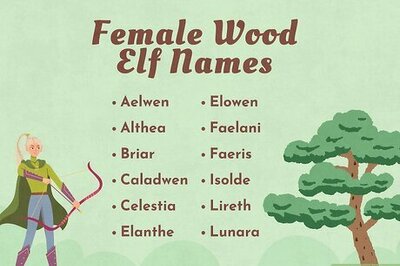
views
Note: If you can't pull a calf out yourself or don't know how, phone your local large animal veterinarian to get him/her to help. Some malpresentations such as belly or back presentation cannot be corrected by hand and instead must be delivered immediately by Caesarian section.
Find the cow or heifer. Usually a female that is in labour will go find a secluded spot away from the herd to calve out. Make sure, during the defined calving season, that you have the heavily pregnant cows close by so that you, nor they, have a long distance to travel in case any of them need assistance.
Observe what stage of birth she's in. A female that is in her first stages of birth will be pacing around, getting up and laying down repeatedly. When she is very close, you will see a water sac hanging down from her vulva: it's a yellowish spherical sac. Usually, soon after you see the water sac, both the front feet will appear, soon followed by the nose. A calf in normal presentation will have the base of the feet pointing to the ground. If the base of the feet are pointing up, then you have a breach calf. If she has been in that position for the last hour or two, and hasn't progressed any further, then it's time to get her in the head gate and help her out.
Restrain the cow, if necessary. If she's down on the ground and is tame enough to let you near to start to help her pulling out the calf, then you can do the assistance right there. If not, if you have a head-gate set up nearby, get her in that where you can easily and quickly pull the calf. If you don't have a head gate, use a gate (preferably 10' or more) to restrain her. However, a head-gate is a more safer and better option for calving out cows, because it prevents them from backing up on you if they start to panic.
Clean your hands and arms from your shoulders down. If you have shoulder gloves on hand, then you should put those on. After you have put some lubricant on the gloves, reach inside the cow or heifer (through the vagina or birth canal, not the anus) to see how the calf is positioned. For backward positions, don't bother trying to twist the calf around. Put the calving chains on (with the handles) or a good flexible rope and pull the calf out as quickly as you can. But only do this if the hind feet are presented. For breach positions (where the calf is arriving tail-first), you will need to bring the hind legs up so that they are positioned in the birth canal. To do this, push the calf forward into the uterus as much as you can. Next, push the flexed hock outward (or away from the calf), and swing the flexed fetlock (of the foot) back inward. Keep the fetlock and hock joints tightly flexed and bring the fetlock joint and foot over the pelvic brim (which is towards you) into the birth canal. Repeat with the other leg. Then put the chains or rope on and start pulling. For head-back or head-down positions, push the calf back into the uterine cavity, cup your hand around the calf's nose and with the other holding the calf stable, bring the head to the normal position. If you can't quite reach the head, you can hook your fingers in the corner of the calf's mouth to bring it part way around. Then you can do the rest as explained previously to bring the head around. For fore-leg-back positions, push the calf back into the uterus, grasp the upper leg and pull it forward enough to bring the knee forward. Then flex the knee tightly and pull it forward. With the knee now tightly flexed, cup the hoof with your hand and gently but firmly bring it up to normal position. For bent-toe or caught-elbow positions, you will need to push the calf back to reposition the foot or elbow. For the bent toe, pushing the calf back may help correct the malpresentation itself. For the caught-elbow, when you have pushed the calf back into the uterus, grab the leg that is more back than the other and pull it forward. Once corrected, the calf should come easily.
If the calf is in normal position or in a position where you can pull from, put a set of calving chains or a rope (not twine, as twine is often too thin and too sharp to be used on a calf) on the front legs of the calf. Use a double half-hitch knot to put the chains on: one loop on the fetlock, the other just below the knee. Pull out and down when the cow is straining, and rest when the cow is not straining. If you have a calf-puller handy, use that too, though be careful of how quick you pull the calf out, as you could easily cause more damage if not handled correctly. The calf puller should have the U-shaped part braced against the rear of the cow, with the chain attached to this part up behind the base of the cow's tail, with the calving chains that are attached to the legs of the calf, and the leaver to ratchet the calf out upwards. Tighten up the tension on the chains. Once you have reached tension, ratchet slowly, and work with the cow's contractions. Once you have made more tension to ease the calf out, move the puller down then back up, then increase the tension again. Repeat until you no longer need the puller (which is when the calf is half-out), then quickly unhook the chains from the puller and do the rest by hand.
Once the calf is out, you must try to get it breathing right away. Clean out the calf's nose with your fingers to get all the amniotic fluid out. Tickle it's nose with a clean piece of straw or hay, put some water in its ears to make it shake its head, or if necessary, you may have to perform artificial respiration to get the calf going. A calf should start to breath within 30 to 60 seconds after birth.
Once the calf has given signs that it is breathing and alive, carry or drag it to a pen with clean straw, then let the new momma cow out to be with her young.
Leave the cow and her newborn calf alone for a while to allow the cow to mother-up to the calf, clean the calf off, and urge him to start nursing. Make sure there is some hay and water for the cow to keep her happy while she gets to know her new youngster.




















Comments
0 comment